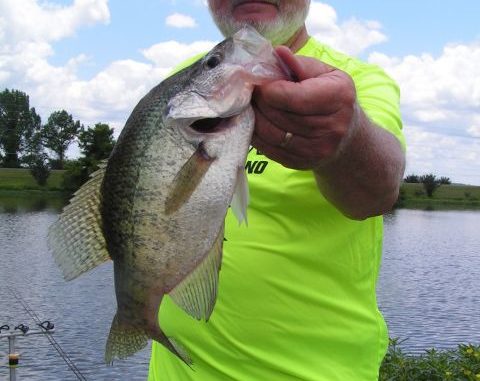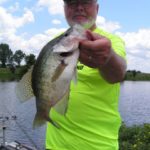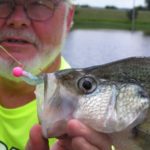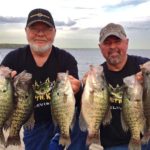
For this Lake D’Arbonne angler, consistently catching crappie means having a plan. And it’s one you can use to keep the grease popping.
James Morgan always seems to have a plan. It’s part of his DNA.
And when it comes to crappie fishing, the only CSI you need is to discover is that he’s a Crappie Seeking Individual.
Part of his plan was moving to Lake D’Arbonne in Farmerville when he retired, but that was really just a subplot.
The main story line was changing his pace of life.
“I told my wife six years ago I was going to slow down and start enjoying life,” Morgan said. “I bought a boat and started to crappie fish. That’s all I want to do.
“I hooked in with some serious crappie fishermen and learned a lot. I’ve never done anything better.”
Morgan’s penchant for planning also includes when he goes on the water.
“I always have a plan of where I’m going and how I’ll fish,” he explained. “But I am also looking at my watch. I set a time limit, and if what I’m doing isn’t working, when times up, I go do something else.”
While that DNA-driven planning comes natural, it was sharpened with 30 plus years working in the maintenance field in the paper and other industries. He liked his work, but he loves crappie fishing.
“One thing I love is the continual excitement of it,” Morgan said. “It’s not like bass fishing, where maybe you’ll catch seven or eight (fish) all day. With crappie fishing there is steady anticipation.”
And then there is the camaraderie. Morgan said even in crappie fishing tournaments there are always people willing to help you.
“It’s not like any other sport,” he said. “People will share information and techniques, and I’ve even had them give me baits on the lake. I do the same for them.
“If you pass someone else crappie fishing, they’ll ask how you are doing and if you aren’t catching, they’ll say try this depth or try this bait. It’s a friendly sport.”
All that is great, but what’s really important is putting filets in the grease.
“There is no finer fish or seafood you can put in your mouth than a fried crappie fillet,” Morgan said.
Here’s how Morgan, or “SouthernChuter” as he’s known on a crappie-fishing forum in which he’s active, has consistent success each spring on the 16,000 acre Union Parish lake.
“My ideal fishing trip in March and April on D’Arbonne or any big lake is single-poling with an 11-foot rod around structure with black-and-chartreuse jigs,” he explained. “I know you can catch with them, but I rarely buy shiners.
“I like taking an 1/8-ounce jighead, sickle hook and a bluegrass-colored plastic trailer in various brands from Bobby Garland Slab Slayers, Stinger Shad or Mid-South tube jigs. And no matter what lure I’m fishing, I have a nibble t on it.”
He also uses a Bait Pump with tube jigs, filling his jig bodies with nibblets. He likes that because you don’t have to add an individual crappie treat every time you pull the bait out of the water.
He has a two-step approach to targeting fish.
“The fish will be on cypress trees or stumps or sometimes old boathouse piers in anywhere from 18 inches to 3 feet of water,” Morgan said.
While he fishes this structure with a jig, he’ll turn to another lure to probe areas beneath the piers and overhanging limbs.
“I also like to use a mini-cast to toss a Roadrunner spinner up under the structure, but it isn’t as easy to get it right on the tree,” Morgan said.
Most of the fish he catches in these areas are males.
He also targets spring fish on flats in 8 to 12 feet of water, where females might be holding.
That’s because females will go in to nests, lay eggs and then get out of there. And then they normally hold on the nearest flat, usually near deeper water, Morgan said.
For these deeper waters, the angler uses two poles, often slow-trolling between the banks and the flats in 6 to 8 feet of water.
He knows he’ll hit on some fish in either the shallow or the deeper water.
“They’ve got to be in one of those places,” he said.
Again, he goes by the plan and if they aren’t at Point A, he goes to Point B and then Point C.
It’s the understanding of a crappie’s life cycle that helps him narrow down his plan.
“The biggest difference in spring and the rest of the year is that during the spawn you are looking for spawning areas,” Morgan said. “The rest of the year, you are looking for baitfish.
“Crappie are going to spawn shallow, but they also spawn in areas their instincts tell them will give their offspring a chance to hide and survive.”
Spring fishing often finds lakes like D’Arbonne in flux, with spring rains muddying up water and varying water temperatures. That often makes the spawn an on-again, off-again proposition.
Morgan finds fish going shallow when the water nears the mid-60-degree mark.
“You have to remember that, on big lakes like this one, the water temperature isn’t always the same everywhere,” he explained. “And when cold rains or a front cools it off in some areas, it might not be as dramatic in other areas.”
For instance, Morgan said D’Arbonne areas like Bear Creek and Stowe Creek hold water temps better than areas like D’Arbonne and Corney creeks.
“Look for areas that are more settled, ones that present more-stable water conditions,” he said. “That’s what the fish look for.
“If there is too much fluctuation, they will put off spawning,” Morgan said. “In extreme cases, some of the fish may even hold on to (their eggs and never spawn).”
While much of D’Arbonne’s crappie-fishing success during the rest of the year comes on the old river channel, which runs from 20 to 35 feet deep, that bite usually slows down in the spring.
But, depending on weather conditions, there still can be a lot of crappie there. And you can catch them suspended anywhere from 10 to 12 to 16 to 18 feet deep.
The key is to follow the bunches of shad that might still be in the channel.
While Morgan doesn’t do it often, sometimes he will fall back on long-lining jigs.
For this tactic, he uses pole holders on the back of his boat, with two 14-foot rods on the outside, two 10-foot poles in the middle and two 6-foot poles out the back.
Morgan will tie on curly tail jigs and troll about 1.4 mph.
Morgan attributed his ability to stay on crappie throughout the year to his work career.
“We tend to be troubleshooters,” he said of maintenance and instrument/electrician workers. “We’ll analyze the situation and try different things until we get it working. You need to do that crappie fishing.
“Don’t get locked in on one area, one bait or one technique. Be ready to do something different. On the other hand, if you are catching, stick with it. In other words, if it ain’t broke, don’t fix it.”


